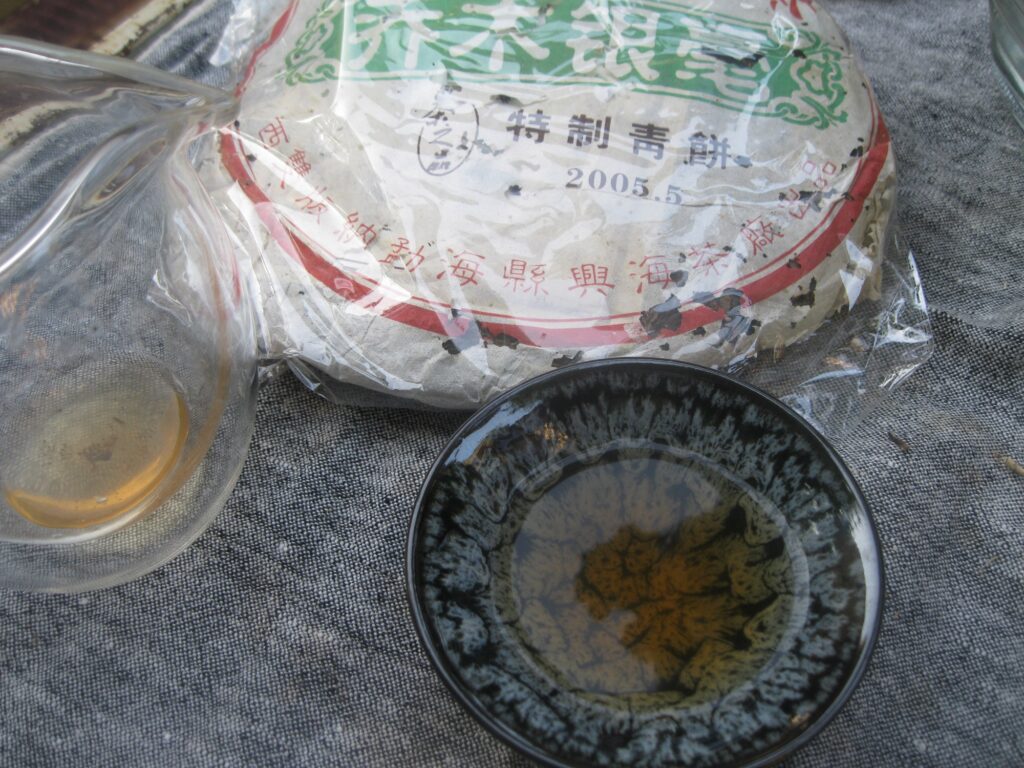Patchouli Puerh

This Sat afternoon the Puerh Junky sat down with the Patchouli Puerh. It’s from an order received in Jun or Jul of 2020. The Patchouli Puerh bears the real name of ’03 Big Tree White Buds and hails from the Xinghai TF. This is the first real tasting.
Sandalwood commonly characterizes the dry aroma of puerhs entering the next phase of transformation. The first time the Puerh Junky encountered this was with a young tuo initially possessing green apple notes. The change was so remarkable, the Puerh Junky spent a good week searching for errant odors that did not exist in storage. These moments of panic are normal when initially storing puerh.
On rare occasion, the taste of incense can be detected in the tea broth, but usually the incense vibe is noticeable only before the leaves are opened. Enter, Patchouli Puerh, but before discussing this intensely curious production, something about Xinghai TF that I haven’t already.
Xinghai Tea Factory
Xinghai TF’s huge puerh operation started up in ’02. According to Baidu they offer over 80 different productions. Their reputation is as solid for raws as ripes. To the Puerh Junky’s horror, he learned that Xinghai bears the nickname of Dayi factory #2. If that is the case, then Dayi is not only fantastic but Xinghai offers the opportunity to taste older Dayis that have either long been snatched up or cost an arm-and-a-leg. Here’s a good site for further exploration. Prices are extremely fair.
The Puerh Junky’s encounter with Xinghai arose from the peacock. Xinghai features a peacock series and peacock brand in addition to individual peacock productions. The varying divisions, series, and grades amidst big factories is befuddling. The only recourse is to stick to one’s thematic guns, choosing thematically or visually interesting wrapper before wading into deeper, i.e., expensive waters.
Now the Reflections
The Patchouli Puerh is a Kunming-moderate stored production from ’05. In fact, the conditions were ideal allowing plenty of transformation while not imparting any humid taste. The first thing you notice is that it doesn’t taste anything as ugly as the broth. I didn’t want to apply the PJRS, focusing more on the experience. At the same time, the variables of the PJRS are integral to the experience. In short, even though I didn’t do any math this is a tremendously ugly tea for the first two infusions.
The contrast between the murky brew and the its taste is disarming. You’re bracing yourself for something sharp and highly opinionated. The reality pauses time, so much Zen in the texture and taste. Underneath the Zen is a maelstrom of tastes, patchouli being prime among them and exceedingly present in the huigan. Additionally, peat, minerals, and the slightest hint of sour that starts to express on the tongue and saliva action in later infusions.
The sour plum is interesting. Some could easily conclude its an awkward teen phase, but if this as awkward it gets then I’ll Junky to that! Anyway, the sour is like the chimes and triangles in a symphony. They have a role, but it is very small compared to the woodwinds of patchouli.
Just when you think you have the puerh universe figured out, along comes a treasure like the Patchouli Puerh to let you know you don’t.
